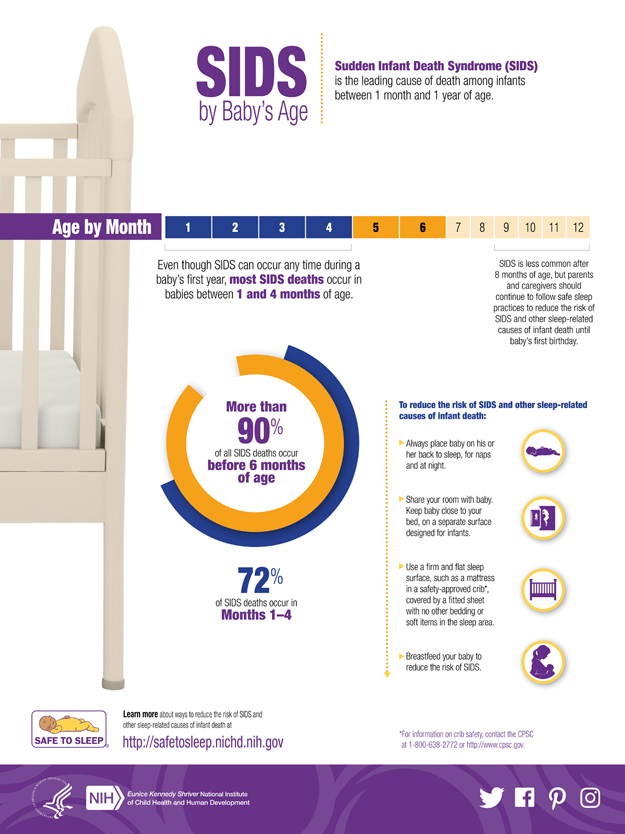Sudden Unexpected Infant Death (SUID), which includes Sudden Infant Death Syndrome (SIDS), is the leading cause of injury death in infancy. It seems theres no scientific explanation for this. SIDS is more likely to occur at certain ages than at others. National Center for Education in Maternal and Child Health. show that in 1994, 27% of babies slept on their back, while in 2009, about 74% of caregivers said that they used the back sleeping position for their babies. I hate to rush the time but I still can't help but feel scared. Some infants are born with problems that make them more likely to die of. However, parents and caregivers should maintain safe sleep practices until a child is over a year old. Maternal smoking during pregnancy and smoke in the infant's environment increase the risk of SIDS. Bed-sharing can increase the risk of SIDS by five times among babies younger than three months old. According to statistics, SIDS was the third leading cause of infant death and the first leading cause of death among infants aged 12 months or younger. The Section on Child Death Review and Prevention (SOCDRP) strives to improve the health and well-being of infants, children, adolescents, and young adults by supporting pediatricians and others in the child death review process to prevent fatalities and near fatalities. A single copy of these materials may be reprinted for noncommercial personal use only. Infants with this abnormality are at a higher risk, but numerous. Its comforting to know that we can help our babies sleep more safely. Being a twin. Babies are at higher risk for SIDS if they: Sleep on their stomachs SOURCE: CDC/NCHS, National Vital Statistics System, Mortality Files. This could be due to colder climates in certain areas. Nevertheless, certain risk factors may trigger SIDS, so its vital to know how we can create a safe sleep environment for babies. *SUID cases were reported as shown below: Sudden infant death syndrome (41%) Unknown cause (32%) Accidental suffocation and strangulation in bed (27%) *Exact values are as follows: Sudden infant death syndrome: 1389 Unknown: 1062 Pregnancy Risk Assessment Monitoring System (PRAMS) Data Narcolepsy in children is rare, but when it does occur, it has a significant impact on daily life. Small Island Developing States (SIDS) include some of the world's smallest and most remote states in the world. SIDS usually occurs when an infant is sleeping. In 2017, there were 35.4 SIDS deaths per 100,000 live births in the US. Although SIDS can occur at any age below 1 year old, it is more common during certain ages than others. In 1980, there were 153 SIDS deaths per 100,000 live births compared to 51.6 in 2010. On the other hand, the highest SUID rate was among American Indian and Alaska Native infants295.8 deaths per 100,000 live births. Although all babies younger than one year are at risk of this type of death, baby boys are more likely to die due to SIDS than baby girls. Place your baby to sleep on his or her back, rather than on the stomach or side, every time you or anyone else put the baby to sleep for the first year of life. What causes babies to die in their sleep? Infographic PDF (542 KB) | Infographic JPG (574 KB), Copy and paste the code below to embed this infographic. Robert Armstrong Cause Of Death,
Subnautica: Below Zero How To Craft Architect Skeleton,
Charles De Gaulle Airport Map 2e To 2f,
Super Bowl Sweepstakes,
Pender County Schools Timekeeper,
Articles S